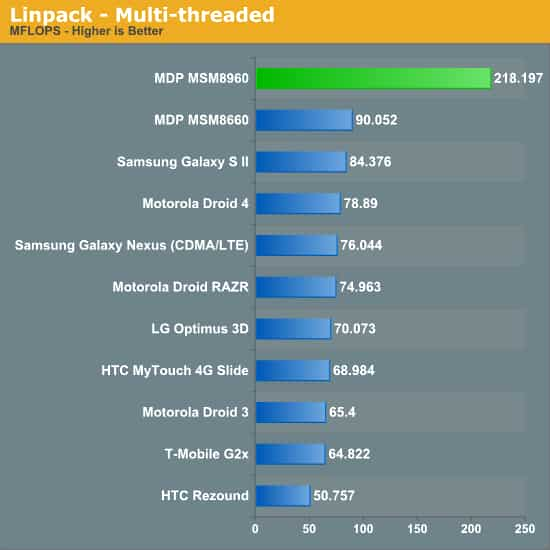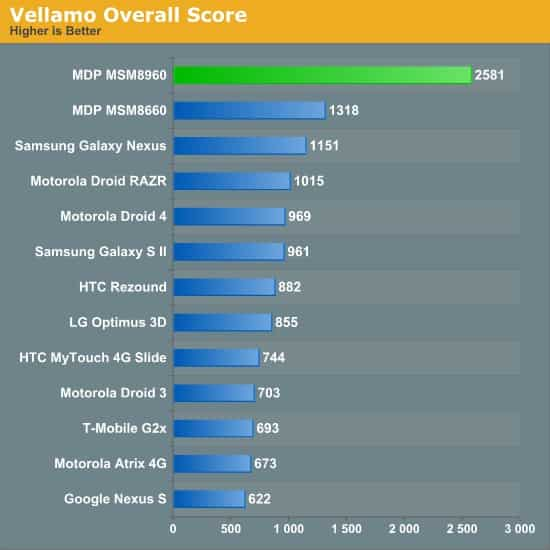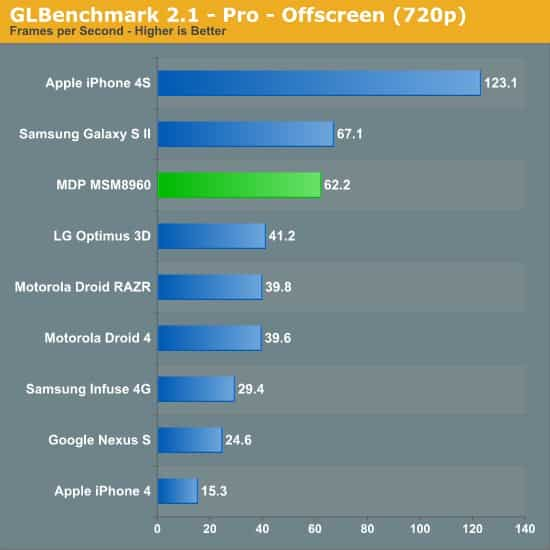Qualcomm's Snapdragon S4 MSM8960 benchmark results are out
During the Mobile World Congress next week we should see several handsets launch based on Qualcomm's new Snapdragon S4 SoC, previously known under the name of Krait. Just ahead of the show benchmarks of the new chip have been published that gives us a good insight as to what to expect from this year's Qualcomm based handset.
During the Mobile World Congress next week we should see several handsets launch based on Qualcomm's new Snapdragon S4 SoC, previously known under the name of Krait. Just ahead of the show benchmarks of the new chip have been published that gives us a good insight as to what to expect from this year's Qualcomm based handset.
Anandtech has posted an extensive set of benchmarks, in as much as you can do on mobile devices these days and has also gone over the general architecture changes that Qualcomm has done. However, we won't be going over the architecture here and suggest you head over to Anandtech and read the full review. That said, we're going to take a quick look at some of the benchmarks, as Qualcomm has come up with a pretty ground breaking chip in terms of performance.
One of the key factors to the Snapdragon S4's performance is that each core in a Krait based SoC can decode and execute three instructions per clock, compared to only two instructions per clock for ARM Cortex-A9 based SoCs. This gives Qualcomm a significant performance lead on paper, but it appears to have paid off in real world applications as well.
In fairly simple benchmarks like Linkpack, the new MSM8960 Snapdragon SoC beats the competition with easy in both single-threaded and multi-threaded runs and we're not talking about a narrow margin here either, as it beats the competition by delivering nearly twice or even over twice the performance. Of course some of this has to do with the larger 1MB cache and improved memory controller as well as the improvements to the actual SoC itself, but it shows that Qualcomm has come up with a very competitive chip design.


In more real world benchmarks the lead isn't as large, but the margins are still there and it's going to take a serious increase in clock speed for the competition to catch up. That said, the MSM8960 is a 1.5GHz chip, whereas most of the competing SoCs that there tested are topping out at about 1.4GHz. Even so, the performance improvements are not directly tied to the slightly higher clock speed. In an easily repeatable benchmark such as Vellamo the MSM8960 offers twice the performance and then some of Google's recently launched Galaxy Nexus. In all fairness, this is a Qualcomm made benchmark, so it's not entirely fair, but it uses several standard web-based benchmarks and offers a good selection of tests.


Qualcomm has also improved the GPU, the Adreno 225. Even though it has eight SIMDs with four MADs per SIMD and a paper performance of 19.2 Gflops at 300MHz, it's not as impressive as you'd think at first. What's worse in a way is the fact that Qualcomm is actually clocking the Adreno 225 at 400MHz in the MSM8960, yet it's having a tough time beating the PowerVR SGX 543MP2 found inside Apple's A4 SoC. As for the other GPUs found on the market today the only one able to offer some kind of competition - and that is only at certain resolutions and tests at that - is ARM's own Mali-400 MP4 found in the Samsung Exynos 4210, i.e. the SoC used on the global version of the Galaxy S II. In all fairness to Qualcomm, the Adreno 225 isn't a bad GPU, but it's not going to last that long in the high-end market segment with several new GPUs expected to arrive in competing products later this year.


For now, Qualcomm is likely to lead the dual core SoC market, although Nvidia's Tegra 3 is at least going to outperform the MSM8960 in CPU intensive tasks where all of its four cores can be used. It's unlikely to be vastly superior in terms of graphics performance though, unless Nvidia has some kind of ace up its sleeve. We'll also have to wait and see what the likes of Texas Instruments, Samsung and the other smaller players have to show. That said, Qualcomm already has a refresh of the MSM8960 planned for September which should see it hitting speeds of 1.7GHz and getting an improved GPU in the shape of the Adreno 320 which should offer vastly improved graphics performance.
Data source: AnandTech
Catch all the Latest Tech News, Mobile News, Laptop News, Gaming news, Wearables News , How To News, also keep up with us on Whatsapp channel,Twitter, Facebook, Google News, and Instagram. For our latest videos, subscribe to our YouTube channel.































